Why Buy Art? Looking Beyond Investment and Recentering Emotional Value
By Alexandra Steinacker-Clark
There’s a long-standing conversation in the art world on the topic of collecting as an act of investment. It can turn into a game of speculation where value is measured in auctions, not emotions. Just watch the recent limited series titled The Great Art Fraud, telling the story of infamous art dealer Inigo Philbrick who conducted one of the largest art frauds in history, conning collectors and investors out of millions. It was a ponzi-scheme approach of selling artworks to multiple buyers, leveraging the art market’s opacity. One of the reasons why this worked is because, for collectors, the opportunities of owning - even fractionally - a sought-after work on the market with a reputable dealer fueled their desires to buy.
VOLTA Basel 2025
I often ask myself why people collect… Are they acquiring works with the dream of catching the next Warhol or Koons before the market boom, or are they the type of collector that chooses with a motivation of more personal nature? I guess in a way, for a lot of people, it is both, and I believe that it’s understandable in the age we live in today for that to be the case. Although the notion of buying art to sell it for profit later down the line, or at least for collectors wanting to have confidence that the value of their collection is growing overall, is grounded in truth, for many art collectors, their reasoning behind collecting is far more emotional. When speaking to dedicated collectors, ultimately they buy with their hearts, and the financial considerations - although still taken into account - are secondary. Instead of sitting on a high horse glorifying collecting solely out of pure love for a piece, it can be a lot of money to transact, thus I personally believe it’s part and parcel of serious collecting to take market standing into consideration. Not necessarily for the aim of profit, per se, but more in the hopes to be investing in an artist who will have a long and successful career ahead of them. Here we have the characteristic statement we hear in many corners of the art world: invest in artists (not just the art).
VOLTA Basel 2025
Another facet of collecting is how it reflects personal beliefs and passions, which is a powerful motivator. In my TEDx Talk “Can Consuming Art Increase Empathy?” I explored how art can deepen our understanding of others, how it connects us across experiences and cultures - but how our consumption habits in today's society don’t reflect those values. We would rather spend money on designer bags or fast fashion than on art we can live with. Collecting art can be an extension of oneself - one's beliefs, one's passions, or even new lessons learned as someone grows through the messages communicated through a work of art. It’s not merely about owning, but about listening. It’s not just that art reflects who you are - It expands the notion of identity in deeply valuable and emotional ways. When you live with art, it becomes part of your daily rhythm. It reflects back your own story while inviting in someone else’s.
VOLTA Basel 2025
For me, this shift became personal when I started my own collecting journey. Like many young art professionals, I began with admiration. Browsing fairs, exhibitions, and artist studios, imagining which works I might one day bring home, and also having the privilege of working with artists whose work I greatly admired. The first piece I truly fell in love with at the time I could finally begin to afford collecting wasn’t the most expensive or the most fashionable. By painter Paula Turmina, the work’s narrative intertwined with my own when I saw it and for me, it became a conversation between the artist’s voice and my lived experience. It’s an uncomfortable piece, slightly abject and bodily. When I showed it to my friends, they didn’t think I should buy it. However, I’m glad I didn’t listen to external opinions because the painting remains one of my favourites to look at every day on my wall, even years later.
That, to me, is what love in art feels like. It’s not simply about aesthetics. It’s not a match of colors to your living room or a name you can drop at a dinner party. It’s that inexplicable pull, where you find yourself drawn back to a work again and again because it says something you didn’t know how to articulate yourself. This kind of collecting - led by connection rather than commerce - doesn’t mean ignoring value altogether. Art is still an investment, of course: financial, emotional, and intellectual. The balance lies in understanding that one does not diminish the other. To reiterate my earlier point, when you buy a piece you love, you invest in the artist’s future, in their ability to keep creating. And perhaps, in time, that work appreciates not just in price, but in meaning, as well.
VOLTA Basel 2025
What I’ve noticed, especially among younger collectors, is a growing consciousness around this balance. The new generation of buyers isn’t just chasing blue-chip names or high-end auctions, but instead they’re seeking authenticity. They want art that speaks to issues of identity, environment, and connection. They seek out pieces that resonate with their worldview. Listening to advisors, gallerists, and collectors alike, I am learning that it’s less about speculation and more about storytelling. Art has always been a mirror of who we are and what we value. When you invite it into your home, it becomes part of your ecosystem. It changes how you move through your space, how you host, even how you think. In that sense, art collecting is a lifestyle that demands curiosity, empathy, and openness - and when you collect authentically, everything else (like a painting’s future market value) becomes secondary.




